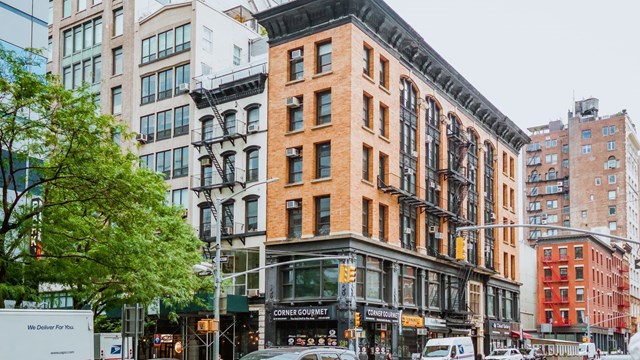An old adage of the real estate game speaks of the importance of "location, location, location," meaning that value goes up (or down) depending on where a property for sale is located. The hot 'location' in New York is constantly moving. Also moving is the overall real estate landscape of a shifting economy and the changing needs of new demographics.
How did 2006 look for the co-op/condo real estate market based on the above factors?
According to the experts, the economy in New York City in 2006 was strong and helped to support a successful real estate market. The city enjoyed low unemployment and a robust economy—two factors that will inexorably help to ensure a stable real estate market.
"The economy has remained strong, and the underlying factors of residential real estate still remain very strong. This has helped add fuel to the fire for residential sales pricing," says Daren Hornig, managing partner for SAXA Inc., a real estate development company based in Arizona, with offices in New York City.
And according to Kirk Henckels, executive vice president, director of private brokerage, and the author of Stribling's Private Brokerage Luxury Residential report, the higher end of the co-op/condo market continued to perform well, although sales were not at the pace seen in previous years.
"The much discussed surge in the accumulated wealth of America's most affluent individuals has never been more apparent than in the results of the 2006 Manhattan luxury real estate market, as defined by residential sales of $5 million and up," Henckels says. "This segment of the real estate market simply behaves differently than the rest of the residential market. It peaked later and continues to set records, though maybe not with the same gusto as in 2005 and 2004," he adds.
Henckels pointed out that residential buying patterns are usually cyclical. "The yearly seasonal patterns of the market have been remarkably the same over the past three years. As we entered each January, usually a quiet month, strong Wall Street bonuses and hedge fund money fueled an early surge in luxury residential sales which continued each year into our typically strong spring market, until inventory was severely diminished to a level that discouraged buyers," Henckels wrote.
At that point, he says, decreased activity leads to talk of a real estate bubble, and other political and economic issues such as increased gasoline prices, interest rate hikes, and the war abroad in Iraq, for example, negatively affect consumer attitudes and in turn, influence residential real estate.
"In each of the last three years, this consumer negativity continued through the summer, the traditional nadir of the residential market, only to disappear after Labor Day. In each case, and to many people's surprise, the fall market resurged earlier than usual and, yet again, to new heights each year due to the sheer amount of money available as well as improved consumer attitudes. However, with each subsequent year, the acceleration of the activity subsided somewhat, from a roiling boil in 2004 to what is now a very balanced, strong market as we enter 2007."
The Well-Adjusted Market
Be wary about looking at how the overall economy impacts the New York City real estate market, however. Many people make the mistake of looking at the nationwide perspective instead of the local perspective, warns Jacky Teplitzky, an executive vice president at Prudential Douglas Elliman and one of the top brokers in the city.
For instance, New York City entry-level jobs in the financial sector often start at $125,000 per year, according to Teplitzky, much higher than the nationwide average.
As compared to the early 2000s, the co-op/condo buying market is now seeing an influx of first-time homebuyers. This demographic is a younger, professional set who more than likely has a family and also demands luxurious amenities.
"I think the market is being driven by the top-down these days, whereas it used to be driven by lots of small one- and two-bedroom apartments," explains Steve Goldschmidt, managing director at Warburg Realty Partnership, a leading real estate brokerage firm. "The dynamics of the marketplace have changed. More people are interested in owning than renting, so we see a whole wave of first-time buyers coming into the market, especially condominium buyers."
This flood of new buyers had a noticeable effect in 2005, when "everything was just flying off the shelf," according to Teplitzky. In 2006, which was more of a flat market on the residential side, sellers had the perception that everything was going to keep flying off the shelf. As a result, they based pricing on the previous year, adding 10 to 15 percent onto their asking prices starting in early 2006.
But it didn't work. The slew of new buyers was unwilling to pay these inflated sales prices. At the same time, there was a steady increase in inventory to offset demand. Therefore, buyers were able to take their time deciding whether or not to buy.
"This resulted in a more stagnant market because people could take longer to make a decision," says Teplitzky. "And they realized they had more leverage, and therefore more negotiability. We ended up with resistance from the buyers to buy—but the sellers did not want to reduce their prices—so we basically had a little bit of a standstill situation in 2006."
The Luxury Market Stays Strong
The average price these days of the typical Manhattan apartment is $1.2 million to $1.3 million. According to Yale Robbins Inc.'s Condo-Sales.com, 7,644 one-, two- and three-bedroom apartment sales were recorded throughout 2006 compared to 6,864 in 2005. Condominium sales peaked in July 2006 with 867 apartments changing hands, and were at their lowest in January 2006 when only 414 units were sold.
According to Stribling, in 2006, the total sales of cooperatives over $5 million exceeded the $1 billion mark for the first time, increasing a remarkable 40.4 percent to $1,376,452,286 from $980,426,421 in 2005. This is largely due to the number of transactions that exceeded $20 million: there were 11 such sales in 2006 versus only 4 in 2005. Sales in the higher end of the market also increased 38.4 percent compared to 2005 - due to an influx of new inventory onto the market in the latter half of 2006.
But 2006 was far from a seller's market. Only around 35 percent of sales met or exceeded the asking price compared to 46.4 percent in 2005, according to the Stribling report.
The increase in the $20 million and up market is worthy of further comment," continues Henckels. "As stated, it was caused by the almost unprecedented accumulation of wealth by hedge fund managers and was buoyed further by various corporate and entertainment moguls. But these sales cannot occur without a supply of rarely available, top quality trophy properties. Indeed, the top five of the 11 sales over $20 million were one of a kind penthouses. Of these, 3 were on Fifth Avenue, 2 were on Central Park West and they ranged in price from $25 million to $31.5 million."
For the second year in a row, the highest cooperative sale, located at 810 Fifth Avenue, had a Rockefeller provenance, having belonged to Nelson Rockefeller at one time. Likewise, the top sale in 2005 was the $44 million sale of the Lawrence Rockefeller estate at 834 Fifth Avenue to Rupert Murdoch, which in turn broke the previous cooperative record set in 2000 of the reported $36 million sale of John D. Rockefeller, Jr.'s former apartment at 740 Park Avenue. Bottom line, the all-time top three highest cooperative sales all belonged to Rockefellers at one time or another. If you are currently selling a large apartment and your name is not Rockefeller, you might want to consider changing your name, quips Henckels.
The second and third highest cooperative sales in 2006 are also worthy of mentioning: the $30 million sale of the former Jacqueline Kennedy Onassis penthouse at 1040 Fifth Avenue and the $27.5 million sale of the Enid Annenberg Haupt estate at 740 Park. The former, with about 5,300 square feet comes in at about $5,660 per square foot exclusive of terraces and the latter, with only 3,600 square feet, is the equivalent of an extraordinary $7,638 per square foot, exclusive of terraces, which must be a record on a per square foot basis. A more typical sale of a quality cooperative would be $1,700 to $2,200 per square foot.
"The main point to be derived from these outrageous numbers is that the one of a kind, trophy apartments have seen large price increases this year, certainly more than any segment of the residential market," notes Henckels. "It also reflects how little money actually means to this sector of buyers if a particular property is exactly what they want."
Conversely, at the end of January 2007, there were already a pair of cooperatives sold over $20 million and another one pending, as well as 49 cooperatives over $5 million with signed contracts. Among townhouses and condos, some notable sales occurred as well.
Like cooperatives, the single-family townhouse market showed significant gains in dollar volume, increasing 21.7 percent to $944,035,562 in 2006 from $758,648,596 in 2005. The condominium market also enjoyed the same exuberance in record sales. The success of both the Plaza Residences and 15 Central Park West has been well-documented, Henckels explains, and each has many sales over $20 million, and a few over $40 million. For example, 15 CPW reported 18 signed contracts over $20 million.
Any pricing fluctuations in the overall market can best be attributed to the market correcting itself after some of the record high prices over the last few years. Sellers therefore became more realistic in their pricing.
"Buyers had more inventory to choose from and just weren't overcome by this panic that seemed to grip the market a year and a half ago, when you had to make a decision in fifteen minutes about whether or not to buy an apartment," agrees Goldschmidt. "Once buyers began to realize they could take their time, it took longer to sell."
But now that this correction has taken hold, Goldschmidt says that January 2007 was an extremely active month, with brokers reporting record traffic at open houses.
Another factor impacting the number of buyers coming onto the scene was the rental real estate market. Across the board, people were seeing 10 to 15 percent increases in rents on their rental renewal notifications, says Teplitzky. This created more buyers who were opting to buy rather than rent.
Condos, Condos Everywhere
As new construction is completed and waves of conversions hit the city, there's no doubt that the trend is moving toward condominium ownership. The same old reasons apply—people who own condos can sell freely without restrictions on the buyer, as well as lease their apartment if the need arises.
According to the Real Estate Board of New York (REBNY), there are nearly 18,000 units that were either under construction or proposed for development in Manhattan in 2006. And according to Yale Robbins Inc.'s Guide to Construction Activity in New York City, another 19,275 units of new and renovated construction are on the drawing board for 2007-08. And the majority of that new and proposed construction is condominium in nature.
"The demand for condos is definitely greater," says Hornig. "You may see more co-op sales, but that's only because there are still twice as many co-ops in New York City than there are condos. But very few new developments - I only know of two - are actually co-ops."
Pampered and Tech-Savvy
According to the experts, people buying apartments these days tend to be younger and more family-oriented than in previous years. The new demographic requires different amenities than in the past. These new buyers want children's playrooms, family rooms, storage areas/bins, bike rooms, as well as gyms complete with squash courts, swimming pools and/or outdoor space.
In addition, young professionals are looking for spa-like pampering and also are technology-savvy buyers who want state-of-the-art wiring for computer access and T1 lines, large walls in their family rooms for wide-screen TVs, and a 'virtual concierge' that lets them order theater tickets and make restaurant reservations, as guests do in a hotel.
"New York City is becoming a city of families," says Teplitzky. "This is a huge change which definitely affects the real estate market."
She goes on to say that developers are now focusing where the market is - on smaller buildings with larger units to accommodate growing families.
Experts say that Manhattan continues to be where everything's happening.
"People are eager to buy in Manhattan because of its value and its convenience," says Goldschmidt. "There's nothing like Manhattan and its perceived value. People who buy in areas of Queens and Brooklyn are still considered more pioneers than they are anyplace else."
"Manhattan is really taking on a supply and demand issue," agrees Hornig. "It's an island 13 miles long and 2 or 3 miles wide—so you see a lot of in-sell, where development is happening between buildings."
Thoughts on the Future
In a city like New York, land is limited. So it's inevitable that every bit of land will be developed to its highest and best use. Areas outside of Manhattan continue to see increased development and interest. Experts predict that 2007 will be a big year for new 'hot' areas.
Hornig's opinion is that "Chelsea is going to continue to expand significantly. I think the Hudson Yards are really going to expand—that will be the area with the most growth potential and still have access to midtown Manhattan. And I think the market, from a residential standpoint, is going to move north. Harlem's going to get hotter, and the Bronx is going to get hot."
Goldschmidt agrees. "The area of Hudson Yards, the area north of Chelsea, are prime areas for development," he says. "That area has already been re-zoned, and the Number 7 subway is going to be extended further west. The Far West Side is a very interesting place."
As lukewarm areas get hotter, hot areas might cool. Hornig warns that Brooklyn might have too much supply coming on, which could have a negative impact on pricing.
For his part, Goldschmidt refuses to believe any areas in the city could be cooling.
"Any coolness is day-by-day," he argues. "Just when you think Second Avenue is going to be a problem because of the construction over the next ten years of the Second Avenue subway, half a dozen new projects are announced for that area. So, the whole city is busy."
Given all the development activity, it begs the question—will the supply of apartments in the city ever approach the actual demand for them?
Hornig points out that a changing political environment in the city could also have a potential effect on the market. Particularly, Goldschmidt brings up Mayor Bloomberg's proposed 421-a property tax abatement plan.
"This could be a critical selling point," he hints. "People who miss out on buying condos this year that next year would have the 421-a tax abatement, will look back and really regret [not buying] because the savings would have been in the hundreds of thousands of dollars over ten years."
Domini Hedderman is a freelance writer living in Pennsylvania.






Leave a Comment